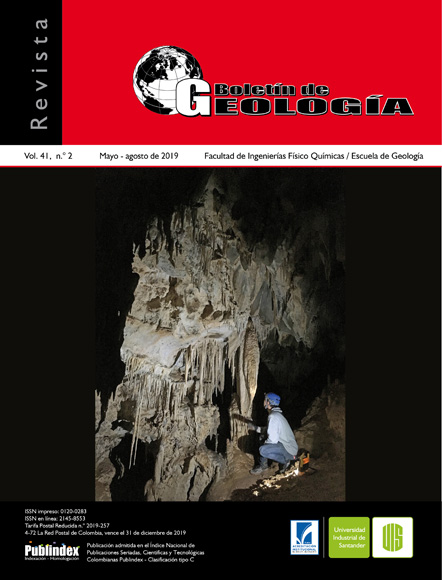Characterization of heavy minerals from active sediments of the Magdalena River basin, Colombia: implications in the provenance analysis of the fluvial record
Published 2019-05-30
Keywords
- Magdalena River,
- heavy minerals,
- recent sands,
- northern Andes,
- provenance
How to Cite
Altmetrics
Abstract
The Magdalena River basin, located on the Colombian Andes, is the most important basin in the country, with an area of 257,400 km2 and altitudes between 0 to 5,670 m. The basin is characterized by having a huge variety of lithological units along an abrupt topography and intense processes of erosion and transport, generating recent sediments with a high concentration of minerals. In the present work, the heavy minerals of 21 recent sand samples from channel bars of the Magdalena River and different first and second order tributary drainages towards the east and west of the basin were analyzed. Drainage from the Central and Western Cordillera are characterized by abundant and well-preserved unstable minerals such as olivine, pyroxene, amphibole and minerals of the epidote group, that have their source areas in the different igneous and metamorphic complexes from this Cordilleras. Drainage derived in the eastern Cordillera showed a predominance of ultrastable zircon and tourmaline minerals, coming from sedimentary sequences. On the other hand, the Magdalena River is characterized by a mixed proportion of unstable, metastable and ultrastable minerals of its different tributary rivers. The results confirm that on a regional scale, heavy minerals from first and second order drainages are highly diagnostic of the geology of the source area while third order and regional scales drainages, due to their mixed nature, tend to obliterate the proportions of heavy minerals, being therefore less diagnostic in terms of provenance. Additionally, the preservation of highly unstable mineral phases in the analyzed samples, suggests that in tropical climates, the topography plays a fundamental role in the efficiency of weathering and the preservation of mineral species.
Downloads
References
ESRI. (2011). ArcGIS Desktop: Release 10. Redlands, CA: Environmental Systems Research Institute. Consultado el 20 de marzo de 2014. https://www.esri.com/es-es/home.
Garzanti, E., and Andò, S. (2007a). Heavy mineral concentration in modern sands: implications for provenance interpretation. In: M.A. Mange, D.T. Wright (eds.). Developments in Sedimentology (pp. 517-545). Vol. 58, Amsterdam: Elsevier. doi: 10.1016/S0070-4571(07)58020-9.
Garzanti, E., and Andò, S. (2007b). Plate tectonics and heavy mineral suites of modern sands. In: M.A. Mange, D.T. Wright (eds.). Developments in Sedimentology (pp. 741-763). Vol. 58. Amsterdam: Elsevier. doi: 10.1016/S0070-4571(07)58029-5.
Gómez, J., Nivia, A., Montes, N.E., Jiménez, D.M., Tejada, M.L., Sepúlveda, J., Osorio, J.A., Gaona, T., Diederix, H., Uribe, H., y Mora, M. (2007). Mapa Geológico de Colombia, escala 1:2´800.000. INGEOMINAS, 2da ed., Bogotá.
González, H. (1999). Geología del departamento de Antioquia. INGEOMINAS, Bogotá. Comprende mapa a escala 1:400.000 e informe, 241 p.
IDEAM. (2001). Estudio ambiental de la Cuenca Magdalena - Cauca y elementos para su ordenamiento territorial. Bogotá: Acuerdo IDEAM-Cormagdalena.
IGAC. (2017). Sistema de Información geográfica para la planeación y el ordenamiento territorial. SIGOT. Consultado el 09 de agosto de 2017. http://sigotn.igac.gov.co/sigotn/frames_pagina.aspx.
Ingersoll, R.V., Kretchmer, A.G., and Valles, P.K. (1993). The effect of sampling scale on actualistic sandstone petrofacies. Sedimentology, 40(5), 937-953. doi: 10.1111/j.1365-3091.1993.tb01370.x.
Leyva, P. (2001). El medio ambiente en Colombia. Bogotá: IDEAM, Ministerio del Medio Ambiente, 2da Edición.
Mange, M., and Maurer, H. (1992). Heavy Minerals in Colour. London: Chapman & Hall.
Morton, A.C., and Hallsworth, C.R. (1999). Processes controlling the composition of heavy mineral assemblages in sandstones. Sedimentary Geology, 124(1-4), 3-29. doi: 10.1016/S0037-0738(98)00118-3.
Nie, J., Horton, B., Saylor, J., Mora, A., Mange, M., Garzione, C., Basu, A., Moreno, C., Caballero, V., and Parra, M. (2012). Integrated provenance analysis of a convergent retroarc foreland system: U–Pb ages, heavy minerals, Nd isotopes, and sandstone compositions of the Middle Magdalena Valley basin, northern Andes, Colombia. Earth-Science Reviews, 110(1-4), 111-126. doi: 10.1016/j.earscirev.2011.11.002.
Nivia, Á. (2001). Geología del departamento del Valle del Cauca. INGEOMINAS, Bogotá. Comprende mapa a escala 1:250.000 e informe, 149 p.
Pepper, M., Gehrels, G., Pullen, A., Ibanez-Mejia, M., Ward, K.M., and Kapp, P. (2016). Magmatic history and crustal genesis of western South America: Constraints from U-Pb ages and Hf isotopes of detrital zircons in modern rivers. Geosphere, 12(5), 1532-1555. doi: 10.1130/GES01315.1.
Pettijohn, F.J., Potter, P.E., and Siever, R. (1987). Sand and sandstone. New York: Springer.
Radelli, L. (1962). Introducción al estudio de la petrografía del Macizo de Garzón (Huila-Colombia). Geología Colombiana, 3, 17-46.
Restrepo, J. (2006). Los sedimentos del río Magdalena: reflejo de la crisis ambiental. Medellín: Fondo Editorial Universidad EAFIT.
Riezebos, P. (1979). Compositional downstream variation of opaque and translucent heavy residues in some modern Río Magdalena sands. Sedimentary Geology, 24(3-4), 197-225. doi: 10.1016/0037-0738(79)90070-8.
Sevastjanova, I., Hall, R., and Alderton, D. (2012). A detrital heavy mineral viewpoint on sediment provenance and tropical weathering in SE Asia. Sedimentary Geology, 280, 179-194. doi: 10.1016/j.sedgeo.2012.03.007.
Tello, A.N. (2001). Geología del departamento de Tolima. INGEOMINAS, Bogotá. Comprende mapa a escala 1:250.000 e informe, 101 p.
Turner, G., and Morton, A.C. (2007). The effects of burial diagenesis on detrital heavy mineral grain surface textures. In: M.A. Mange, D.T. Wright (eds.). Developments in Sedimentology (pp. 393-412). Vol. 58. Amsterdam: Elsevier.

